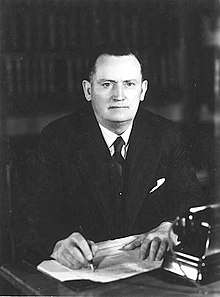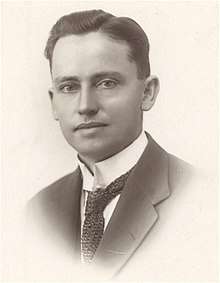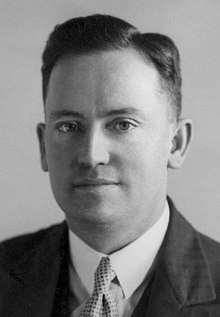Frank Forde
| The Right Honourable Frank Forde | |
|---|---|
 | |
| 15th Prime Minister of Australia | |
|
In office 6 July 1945 – 13 July 1945 | |
| Monarch | George VI |
| Governor-General | Prince Henry, Duke of Gloucester |
| Preceded by | John Curtin |
| Succeeded by | Ben Chifley |
| Deputy Leader of the Labor Party | |
|
In office 16 February 1932 – 31 October 1946 Acting leader: 6 – 13 July 1945 | |
| Leader |
John Curtin Ben Chifley |
| Preceded by | Ted Theodore |
| Succeeded by | H. V. Evatt |
| Member of the Australian Parliament for Capricornia | |
|
In office 16 December 1922 – 28 September 1946 | |
| Preceded by | William Higgs |
| Succeeded by | Charles Davidson |
| Member of the Queensland Legislative Assembly | |
|
In office 12 May 1917 – 5 October 1922 | |
| Preceded by | John Adamson |
| Succeeded by | George Farrell |
| Constituency | Rockhampton |
|
In office 12 March 1955 – 3 August 1957 | |
| Preceded by | Ernest Riordan |
| Succeeded by | Bill Longeran |
| Constituency | Flinders |
| Personal details | |
| Born |
Francis Michael Forde 18 July 1890 Mitchell, Queensland, Australia |
| Died |
28 January 1983 (aged 92) Brisbane, Queensland, Australia |
| Resting place | Toowong Cemetery, Queensland, Australia |
| Political party | Labor |
| Spouse(s) |
Veronica O'Reilly (m. 1925; d. 1967) |
| Children | 4 |
| Education | St Mary's College, Toowoomba |
| Occupation |
Schoolteacher Telegraphist Politician |
Francis Michael Forde (18 July 1890 – 28 January 1983) was an Australian politician who served as Prime Minister of Australia from 6 to 13 July 1945. He held office after the death of John Curtin, and is the shortest-serving prime minister in Australia's history.[1]
Forde was born in Mitchell, Queensland, to Irish immigrant parents. He was a schoolteacher and telegraphist before entering politics, and eventually settled in Rockhampton. Having joined the Labor Party at a young age, Forde was elected to the Queensland Legislative Assembly in 1917, aged 26. He transferred to the House of Representatives at the 1922 federal election, winning the Division of Capricornia. Forde entered cabinet in 1931, serving as Minister for Trade and Customs for what would be the final year of the Scullin Government.
After Labor's landslide defeat at the 1931 election, Forde was elected deputy leader in place of Ted Theodore. He returned to cabinet in 1941 as Minister for the Army in the Curtin Government, and as the de facto deputy prime minister was one of the government's most prominent figures. When John Curtin died in office in 1945, Forde was appointed prime minister to serve while the Labor Party elected a new leader. He contested the leadership ballot against Ben Chifley and Norman Makin, but Chifley emerged victorious.
Forde continued on as deputy leader and army minister in the Chifley Government, but lost his seat at the 1946 election. He then served as High Commissioner to Canada from 1947 to 1953. Forde attempted to re-enter federal parliament in 1954, but was unsuccessful. He won a state by-election in Queensland the following year – the only former prime minister to enter state parliament – but served only a single term before again being defeated. Forde died at the age of 92, and was accorded a state funeral; Gough Whitlam is the only prime minister to have lived to a greater age.
Early life

Forde was born in Mitchell, Queensland, on 18 July 1890. He was the second of six children born to Ellen (née Quirk) and John Forde. His parents were both Irish immigrants – his father was born in Ballinaglera, County Leitrim, while his mother was from County Tipperary. His father was working as a grazier at the time of his birth, and later worked as a railway supervisor. Forde began his education at the local state school, and later boarded at St Mary's College, Toowoomba. He qualified as a schoolteacher via the monitorial system, but at the age of 20 joined Queensland Railways as a clerk in the telegraphy department. He later moved to Brisbane to work as a telegraphist for the Postmaster-General's Department, at the same time studying electrical engineering. In 1914, Forde was transferred to Rockhampton. He was involved with the Australian Natives' Association, the Australian Workers' Union, and the Rockhampton Workers' Political Organisation, and helped campaign for the "No" vote in the conscription referendums of 1916 and 1917.[2][3]
Early political involvement
Forde joined the Labor Party in 1915, at the urging of state MP James Larcombe, who became his mentor. In 1917, aged 26, he won a by-election to the seat of Rockhampton in the Queensland Legislative Assembly. It had been vacated by John Adamson, who had resigned from the Labor Party in the wake of the 1916 party split and unsuccessfully sought Nationalist Party preselection for the Senate. Forde was re-elected to Rockhampton at the 1918 and 1920 state elections. He was a supporter of the Central Queensland Separation Movement, one of the many new state movements active around that time.[4]
In 1921, the state Labor government of Ted Theodore passed controversial legislation that allowed state MPs to run for federal parliament and automatically return to their seat in state parliament if they lost, without having to face a by-election. It was widely reported that Forde was intended to be the primary beneficiary of the new legislation. However, the federal Nationalist government responded by amending the Commonwealth Electoral Act 1918 to overrule the state law. In October 1922, Forde resigned from state parliament to run in the Division of Capricornia at the 1922 federal election. He was successful, defeating Nationalist incumbent and Labor defector William Higgs.[4] Forde's successful foray into federal politics triggered the 1923 Rockhampton by-election. The bitterly fought by-election was successfully contested by Labor's George Farrell, who had worked on Forde's federal campaign.[5][6][7]
Scullin and Curtin Governments

|
|
Initially the youngest MP in federal parliament, Forde soon advanced in the Labor ranks. When Labor won the 1929 election, he became Assistant Minister for Trade and Customs in the Scullin government. In the last days of the government he became Minister for Trade and Customs.[8] As one of the few senior Labor MPs to survive defeat at the 1931 election, Forde became Deputy Opposition Leader in 1932. When Scullin retired in 1935, Forde contested the leadership ballot but was defeated by one vote by John Curtin, mainly because he had supported Scullin's economic policies.[9]
Forde was a loyal deputy, and in 1941 when Labor returned to power he became Minister for the Army, a vital role in wartime.[10]
Prime Minister

In April 1945, Forde left Australia to attend the United Nations Conference on International Organization in San Francisco. Late that month, Curtin was admitted to hospital; in the absence of Forde and H. V. Evatt (the Minister for External Affairs), he designated Ben Chifley as acting prime minister. Forde did not return to Australia until 2 July, but then immediately took over from Chifley. The prime minister's health had severely declined in the mean time, although he had been able to go home to The Lodge. Curtin died in his sleep in the early hours of 5 July, at the age of 60.[11]
On the day that Curtin died, Forde issued a brief statement announcing the death, and then in the afternoon moved a condolence motion at a brief sitting of parliament. On the morning of the following day, 6 July, he led a procession of MPs past Curtin's coffin at Parliament House, where he was lying in state. In the afternoon, Forde attended a memorial service, and then went to Government House, where he was formally sworn in as prime minister by Prince Henry, Duke of Gloucester, the Governor-General. He was appointed as prime minister with the understanding that he would resign if the Labor Party elected someone other than him as leader at its next caucus meeting. Forde was the Labor Party's sixth prime minister, and the fifteenth overall. He is the only Australian prime minister to have never led a political party. There was little precedent for his appointment, as only one previous prime minister (Joseph Lyons) had died in office, and Lyons had been succeeded by the leader of the smaller party in his governing coalition (Earle Page).[11]
On 8 July, Forde accompanied Elsie Curtin to Perth to attend her husband's funeral. Two days later, Ben Chifley told him that he would be contesting the leadership; that evening, they both issued statements announcing their candidacies. Norman Makin announced his intention to stand the following day. On the morning of 12 July, Les Haylen informed Forde that he did not have the numbers to win. In response, Forde said "I must say a little prayer for Ben. It's not an easy job". In the leadership ballot, Chifley received 45 votes to Forde's 16, Makin's seven, and Evatt's two. Several MPs were absent (including Evatt), and Rowley James unsuccessfully proposed that the ballot be postponed. Forde resigned as prime minister on 13 July, after one week in office. He is Australia's shortest-serving prime minister.[11]
Chifley Government

Despite losing the leadership contest to Chifley, Forde was re-elected as deputy leader. As Minister for Defence he was much criticised for the slowness with which military personnel were being demobilised. As a result, he lost his seat at the 1946 election, though the Labor Party itself comfortably retained office.[12]
High Commissioner and return to state politics
Chifley appointed Forde High Commissioner to Canada, and he held this position until 1953. From May 1952, he was the doyen of the diplomatic corps (the longest-serving ambassador).[13] After returning to Australia, he tried to re-enter the House of Representatives at the 1954 election, in the seat of Wide Bay, without success. In 1955, at a by-election, he returned to the Queensland Parliament as MP for Flinders.[12] He is the only Prime Minister who later served in a State Parliament.
At the 1957 Queensland state election the Labor Party split resulted not only in Labor falling from power, but also in Forde being defeated in his own seat by Bill Longeran of the Country Party by one vote. Forde disputed the result and the election was declared void on 4 March 1958. However, at the by-election held on 17 May 1958, Longeran defeated Forde by over 400 votes.[14][12] Had Forde been elected, he would probably have become Labor leader in Queensland, given that Premier Vince Gair and most of Gair's followers had been expelled from the party.
After politics
Forde retired to Brisbane where he devoted himself to Catholic charity work. In his living room hung a large portrait of wartime US General Douglas MacArthur. On 11 April 1964, at the request of Prime Minister Robert Menzies, Forde represented Australia at MacArthur's funeral in Norfolk, Virginia.[12][15]

Forde died in 1983. He was accorded a state funeral which, on 3 February, proceeded from St Thomas Aquinas Catholic Church in St Lucia to the Toowong Cemetery,[16] the same day that Bob Hawke was elected ALP leader. Indeed, it was at Forde's funeral that Senator John Button told then Labor leader Bill Hayden that he must step aside in favour of Hawke, which he did. Forde was the last surviving member of the Scullin, Curtin and his own Cabinet. Furthermore, he was the last surviving MP from when Stanley Bruce was Prime Minister.
Forde was the only deputy Labor leader who served under three leaders (Scullin, Curtin and Chifley) until Jenny Macklin (Crean, Latham and Beazley, 2001–06). The electoral Division of Forde and the Canberra suburb of Forde are named after him.
Family
Forde married Veronica (Vera) Catherine O'Reilly in 1925 and they had four children:[17]
- Mary Therese (1927–2016)
- Mercia (b. 1930)
- Clare (1932–2010)
- Francis Gerard Forde (1935–1966); his widow, Leneen Forde, became Governor of Queensland.
During the years that he spent in Ottawa as High Commissioner to Canada two of his daughters (Mary and Mercia) became married to Canadians. Mary (m. William Robert Thompson) eventually settled with her husband in Kingston, Ontario, Canada while Mercia (m. Ian Ferrier) returned to Australia and settled with her husband in St. Lucia, Brisbane. Francis Gerald Forde (m. Leneen Forde) also settled in St. Lucia, while Clare (m. John Attridge) settled in Canberra. Between his four children, Frank and Vera Forde had 15 grandchildren.
See also
References
- ↑ Francis Forde, Prime Minister from 6 July 1945 to 13 July 1945 – National Museum of Australia
- ↑ Forde, Francis Michael (Frank) (1890–1983), Australian Dictionary of Biography, Vol. 17, 2007.
- ↑ "Frank Forde, Early years". Australia's Prime Ministers. National Archives of Australia. Retrieved 6 February 2010.
- 1 2 Elaine Brown (2000). "Francis Michael Forde". In Michelle Grattan (ed.). Australian Prime Ministers. New Holland. p. 241. ISBN 1-86436-671-0.
- ↑ Rockhampton Election: Mr Farrell's Campaign, The Morning Bulletin, 25 January 1923. Retrieved from National Library of Australia 13 November 2017.
- ↑ The By-Election: Victory for Mr. Farrell, The Morning Bulletin, 19 February 1923. Retrieved from National Library of Australia 13 November 2017.
- ↑ Labour Gatherings: New Branch Formed, The Morning Bulletin, 4 November 1921. Retrieved from National Library of Australia 13 November 2017.
- ↑ "Frank Forde, Scullin government 1929–31". Australia's Prime Ministers. National Archives of Australia. Retrieved 6 February 2010.
- ↑ "Frank Forde, Deputy Leader of the Opposition 1932–???41". Australia's Prime Ministers. National Archives of Australia. Retrieved 6 February 2010.
- ↑ "Frank Forde, Curtin government 1941–45". Australia's Prime Ministers. National Archives of Australia. Retrieved 6 February 2010.
- 1 2 3 Ross McMullin, The Light on the Hill: The Australian Labor Party 1891–1991, pp. 234-235
- 1 2 3 4 "Frank Forde, After office". Australia's Prime Ministers. National Archives of Australia. Retrieved 6 February 2010.
- ↑ Lorna Lloyd (2007). Diplomacy with a Difference: the Commonwealth Office of High Commissioner, 1880-2006. Brill. p. 163. ISBN 9047420594.
- ↑ "Longeran, Hon. William Horace (Bill)". Former Members. Queensland Parliament. Retrieved 3 November 2016.
- ↑ "General Macarthur's Funeral (1964)". British Pathe. 13 April 1964. Retrieved 3 November 2016 – via YouTube.
- ↑ "Family Notices". The Canberra Times. 31 January 1983. p. 10. Retrieved 16 January 2016 – via National Library of Australia.
- ↑ "Frank Forde, Vera Forde". Australia's Prime Ministers. National Archives of Australia. Retrieved 6 February 2010.
- Forde, Francis Michael – Brisbane City Council Grave Location Search
Bibliography
- Carroll, Brian, Australia's Prime Ministers: From Barton to Howard, Rosenberg Publishing, 2004, ISBN 1-877058-22-X
- Hughes, Colin A (1976), Mr Prime Minister. Australian Prime Ministers 1901–1972, Oxford University Press, Melbourne, Victoria, Ch.16. ISBN 0-19-550471-2
External links
| Wikimedia Commons has media related to Frank Forde. |
- "Francis Forde". Australia's Prime Ministers. National Archives of Australia. Retrieved 29 June 2010.
- Saunders, Malcolm. "Forde, Francis Michael (Frank) (1890–1983)". Australian Dictionary of Biography. Canberra: Australian National University. Retrieved 29 June 2010.
- "Francis Forde". National Museum of Australia. Retrieved 29 June 2010.
| Parliament of Australia | ||
|---|---|---|
| Preceded by William Higgs |
Member for Capricornia 1922–1946 |
Succeeded by Charles Davidson |
| Political offices | ||
| Preceded by James Fenton |
Minister for Trade and Customs 1931–1932 |
Succeeded by Henry Somer Gullett |
| Preceded by Percy Spender |
Minister for the Army 1941–1946 |
Succeeded by Cyril Chambers |
| Preceded by John Curtin |
Prime Minister of Australia 1945 |
Succeeded by Ben Chifley |
| Minister for Defence 1945–1946 |
Succeeded by John Dedman | |
| Party political offices | ||
| Preceded by Edward Theodore |
Deputy Leader of the Australian Labor Party 1932–1946 |
Succeeded by H.V. Evatt |
| Diplomatic posts | ||
| Preceded by Alfred Stirling |
Australian High Commissioner to Canada 1946–1953 |
Succeeded by Sir Douglas Copland |
| Parliament of Queensland | ||
| Preceded by John Adamson |
Member for Rockhampton 1917–1922 |
Succeeded by George Farrell |
| Preceded by Ernest Riordan |
Member for Flinders 1955–1957 |
Succeeded by Bill Longeran |
